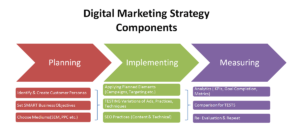A Comprehensive Guide to Implementing the Best Digital Marketing Strategies:
Understanding the Problem: Ineffective Digital Marketing.
Best digital marketing strategies: Digital marketing encompasses strategies like search engine optimization (SEO), content marketing, social media marketing, email marketing, pay-per-click (PPC) advertising, and more. When businesses fail to implement these strategies effectively, they experience challenges such as low website traffic, poor audience engagement, limited brand visibility, and reduced revenue.
Breaking Down the Problem into Components.
-
Lack of Strategy Alignment: Marketing efforts are not aligned with business goals or target audience needs.
-
Inconsistent Content Creation: Poor-quality or sporadic content fails to engage or convert audiences.
-
Ineffective Channel Utilization: Choosing the wrong platforms or underutilizing key channels like social media or email.
-
Insufficient Data Analysis: Failing to track performance metrics or use data to optimize campaigns.
-
Limited Budget or Resources: Small businesses or startups may lack the funds or expertise to execute robust campaigns.
-
Outdated Tactics: Relying on obsolete strategies that don’t align with current digital trends.
Common Causes.
-
Undefined Goals: Businesses may not have clear objectives (e.g., brand awareness, lead generation, sales).
-
Poor Audience Understanding: Lack of research into target demographics, preferences, or behaviors.
-
Inadequate Tools or Skills: Not leveraging modern tools or lacking in-house expertise.
-
Neglecting Trends: Ignoring emerging platforms (e.g., TikTok) or technologies (e.g., AI-driven advertising).
-
Budget Mismanagement: Overspending on low-ROI channels or underfunding high-impact strategies.
Consequences of Not Addressing the Issue.
-
Lost Revenue: Ineffective marketing leads to fewer leads and conversions, directly impacting sales.
-
Brand Obscurity: Competitors with stronger strategies dominate market visibility.
-
Wasted Resources: Time and money spent on ineffective campaigns yield minimal returns.
-
Customer Disconnect: Poor engagement erodes trust and loyalty.
-
Missed Opportunities: Failure to capitalize on trends or new platforms limits growth potential.
Actionable Step-by-Step Solution:
Step 1: Define Clear Goals and KPIs.
-
Action: Establish SMART (Specific, Measurable, Achievable, Relevant, Time-bound) goals for your digital marketing efforts. Examples include increasing website traffic by 20% in six months or generating 100 new leads per month.
-
Tools/Resources: Use Google Analytics or HubSpot to set up goal tracking. Create a KPI dashboard to monitor metrics like click-through rates (CTR), conversion rates, and return on ad spend (ROAS).
-
Example: A local bakery might set a goal to increase online orders by 15% in three months by targeting local customers through social media ads.
Step 2: Conduct Audience Research.
-
Action: Identify your target audience’s demographics, interests, pain points, and preferred platforms. Create buyer personas to guide content and campaign development.
-
Tools/Resources: Use tools like Google Trends, Facebook Audience Insights, or SurveyMonkey to gather data. Analyze competitors’ strategies to identify gaps and opportunities.
-
Example: A fitness brand might discover that its audience (18-35-year-olds) prefers short, motivational videos on Instagram and TikTok, leading to a focus on video content.
Step 3: Develop a multi-channel content strategy.
-
Action: Create high-quality, relevant content tailored to each channel (e.g., blog posts for SEO, videos for social media, newsletters for email). Ensure consistency in tone, branding, and posting frequency.
-
Tools/Resources: Use Canva for visuals, Grammarly for copyediting, and Hootsuite or Buffer for scheduling. Implement a content calendar to plan posts.
-
Example: Dollar Shave Club’s viral video campaign combined humor and storytelling to engage audiences, driving massive brand awareness.
Step 4: Optimize for Search Engines (SEO).
-
Action: Conduct keyword research to identify high-traffic, low-competition terms. Optimize website content, meta tags, and images. Build backlinks through guest blogging or partnerships.
-
Tools/Resources: Use SEMrush, Ahrefs, or Moz for keyword research and SEO audits. Google Search Console can track performance and identify issues.
-
Example: A small e-commerce store increased organic traffic by 30% by optimizing product pages with long-tail keywords like “affordable eco-friendly yoga mats.”
Step 5: Leverage Social Media Marketing.

-
Action: Choose platforms based on audience preferences (e.g., LinkedIn for B2B, Instagram for lifestyle brands). Run targeted ads and engage with followers through comments and stories.
-
Tools/Resources: Use Meta Business Suite for ad management, Later for Instagram scheduling, and Sprout Social for analytics.
-
Example: Glossier built a cult following by leveraging user-generated content on Instagram, encouraging customers to share photos with their products.
Step 6: Implement Email Marketing.
-
Action: Build an email list through lead magnets (e.g., eBooks, discounts). Segment audiences and send personalized, value-driven emails. Use automation for drip campaigns.
-
Tools/Resources: Platforms like Mailchimp, Constant Contact, or Klaviyo offer email templates and automation features.
-
Example: Airbnb uses personalized email campaigns to recommend listings based on user search history, increasing booking rates.
Step 7: Utilize Paid Advertising (PPC).
-
Action: Run targeted ads on Google Ads or social platforms. Set budgets, test ad creatives, and optimize based on performance metrics like CTR and cost-per-click (CPC).
-
Tools/Resources: Google Ads Keyword Planner for bid strategies, Facebook Ads Manager for audience targeting.
-
Example: A SaaS company used Google Ads to target “project management software” keywords, achieving a 10% conversion rate on free trial sign-ups.
Step 8: Analyze and Optimize Campaigns.
-
Action: Regularly review analytics to assess campaign performance. A/B test ad creatives, landing pages, and email subject lines to improve results.
-
Tools/Resources: Google Data Studio for custom reports, Hotjar for heatmaps, and Optimizely for A/B testing.
-
Example: HubSpot increased email open rates by 25% by A/B testing subject lines and personalizing content based on user behavior.
Case Study: How Nike Boosted Engagement with Digital Marketing:
Nike’s “Just Do It” campaign leveraged a multi-channel digital strategy to engage younger audiences. They used:
-
Social Media: Inspirational videos on Instagram and TikTok featuring athletes.
-
Content Marketing: Blog posts and tutorials on fitness and lifestyle.
-
PPC and SEO: Targeted ads and optimized content for keywords like “running shoes.”
-
Email Marketing: Personalized product recommendations and event invites. Results: Nike saw a 20% increase in online sales and a 15% boost in social media engagement within six months.
Tips for Preventing Future Issues.
-
Stay Updated: Follow industry blogs like Moz, HubSpot, or Social Media Today to keep up with trends.
-
Invest in Training: Upskill your team through platforms like Coursera or LinkedIn Learning.
-
Regular Audits: Conduct quarterly audits of your website, SEO, and campaigns to identify weaknesses.
-
Diversify Channels: Avoid over-reliance on one platform; test new channels like emerging social media apps.
-
Budget Wisely: Allocate funds based on ROI analysis, prioritizing high-performing channels.
Next Steps and Call to Action…
-
Start Small: Pick one or two strategies (e.g., SEO and social media) and implement them this week.
-
Set Up Tools: Sign up for free trials of tools like Google Analytics, Canva, or Mailchimp to begin.
-
Create a Plan: Draft a 30-day marketing plan with specific goals and tasks.
-
Seek Expertise: If resources are limited, consider hiring a digital marketing consultant or agency.

1 thought on “Best digital marketing strategies”